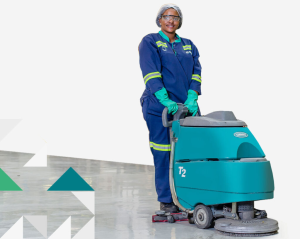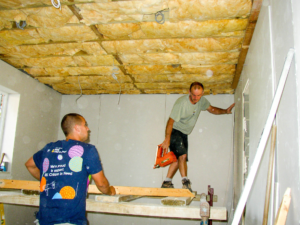Cleaning Services are an excellent opportunity for entrepreneurs who want to earn good money. Many customers trust these businesses, and they can also recommend their services to others.
Professional cleaning companies have access to the best equipment and supplies, and they follow a streamlined procedure. This makes them efficient at their job. Contact WindowWorks LLC now!

The health and safety of cleaning staff is important for any business. Workers in this field are often exposed to dangerous chemicals and work in environments that can be hazardous. It’s critical that a business focus on ways to improve the health and safety of its employees, as well as providing proper equipment and training.
Professional cleaners use specific tools and techniques to perform their tasks. They also have the experience and knowledge to perform their duties faster than in-house employees, saving time and money. This gives businesses peace of mind that their property is in good hands.
Regular cleaning reduces the spread of germs, which leads to fewer sick days for employees. Professional cleaners use hospital-grade disinfectants and follow strict protocols to sanitize spaces. They also focus on high-germ areas like light switches, doorknobs, and keyboards to reduce the risk of illness.
Employees in the cleaning industry must be trained to understand how to operate equipment and follow all governing regulations for their work environment. They may need to know how to safely lift heavy objects or what to do if they’re exposed to harmful cleaning chemicals.
In addition, many cleaning professionals work in confined spaces that can be difficult to ventilate and can pose additional risks. These areas require special permits and different ventilation requirements than the rest of a workspace.
Ergonomics is the concept of fitting a job to the worker, rather than forcing the worker to fit the job. This helps to avoid injuries like back strain and repetitive motions. In the cleaning industry, this can include using long-handled mops that eliminate the need for bending. It can also include making sure that cleaning supplies are stored in a safe location and that there is plenty of space for workers to move around the area.
Enhanced Productivity
When employees are happy and feel supported at work, they are more likely to give their best efforts. It’s one of the reasons why so many businesses invest in team building and training initiatives. Another way to keep your employees productive is by providing a clean environment that makes it easier for them to do their jobs. Enlisting janitorial services is an excellent way to do this!
Professional cleaning companies are well-equipped to adapt their specialized cleaning processes to the needs of each space. They know how to handle everything from small homes and apartments to large offices and commercial spaces. They can also help businesses develop a cleaning schedule that fits their needs and business hours. In addition, they are flexible and willing to change their plans to accommodate any unexpected requests from clients.
Keeping your home or office clean is a time-consuming and laborious task. Having to bend down to scrub floors or dust high surfaces can put strain on your body and drain your energy. It is also difficult to juggle this chore with other responsibilities. By hiring a professional cleaning service, you can avoid the stress of this tedious chore and focus on more important tasks.
A clean home or workspace is a healthy and welcoming place for you and your family. Hiring professional cleaners ensures that your house is free of harmful germs and allergens. These professionals are experts at identifying common germ hotspots and can use hospital-grade disinfectants to minimize the spread of illness in shared spaces. This translates to fewer sick days and a healthier environment overall.
In a commercial setting, frequent cleaning can boost productivity by eliminating distractions and making the workplace more efficient. Keeping your workspace clean can also boost morale and make employees more likely to give their best effort. In addition, a clean workspace can reduce the amount of waste produced in your business. This can save you money in the long run by lowering your operating costs. In addition, it will improve the overall image of your company and help you attract more customers.
Enhanced Customer Relationships
Running a cleaning business provides significant opportunity to establish relationships with clients. It’s a rewarding experience to know that you are helping people make their homes or businesses comfortable and clean. You can provide a wide range of cleaning services, offering a variety of options for different customers’ needs. Your business also offers a lot of room for growth and expansion, providing a lucrative profit margin. You can also grow your team, enabling you to take on more projects in a wider geographical area.
Increased Profits
Profitability depends on the ability to keep overhead costs low while delivering high-quality services. Achieving this requires an accurate picture of current and future costs, including labor, supplies, equipment, marketing, and other operational expenses. Many cleaning businesses use software solutions to track and improve profitability. These tools help managers and teams monitor profit margins on a job-by-job basis, identify areas where improvements can be made, and make proactive decisions to grow profits without compromising quality.
In addition to tracking expenses, cleaning companies can also increase profit by choosing profitable services. This includes specialized commercial cleaning, which can generate higher profit returns due to limited competition and the need for technical equipment and training. Another profitable cleaning service is laundry pick-up and delivery, which provides convenience for busy customers who don’t have time to wash and dry their own clothes. Other profit-enhancing services include organizing and decluttering, as overwhelmed homeowners are willing to pay a premium for someone to take care of their closets, pantries, and other spaces.
Other ways to boost profits include hiring efficient cleaners to keep labor costs low and by purchasing materials in bulk to save on shipping fees. Some cleaning businesses even offer discounts on their services to attract new clients and retain existing ones.
To maximize profits, it’s also important to consider seasonal demand for cleaning services and adjust pricing accordingly. For example, before holidays such as New Year or Christmas, demand tends to rise as people prepare their homes for family gatherings and decorations. Conversely, demand decreases in winter or summer when people aren’t focusing on home improvements and are less likely to hire a professional to help them clean. By understanding demand trends, you can better plan and budget your expenses to maximize profitability.








